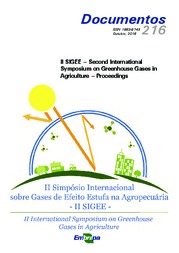An optimization model to deal with livestock production and emissions while maximizing the overall net revenue.
An optimization model to deal with livestock production and emissions while maximizing the overall net revenue.
Autoria: MOREIRA, J. M. M. A. P.; FASIABEN, M. do C. R.; BARIONI, L. G.; OLIVEIRA, A. F. de; COSTA, F. P.; DIAS, F. R. T.; ABREU, U. G. P. de; SANTOS, J. C. dos; SENA, A. L. dos S.; LAMPERT, V. do N.; OLIVEIRA, P. P. A.; PEDROSO, A. de F.; SILVA, R. de O.
Resumo: The Brazil is second world´s largest beef producer (FAO, 2016), with a great variety of climate and natural resources on its Biomas. The grassland area allocated to livestock systems is about 170 Mha, with a great variety of production systems adopted on each one of them (IBGE, 2016). Beef production systems have different input of resources and result on different outputs, as beef, money and greenhouse gases (GEE) emissions. Finding promising solutions dealing with the complexity of the drivers of the trade-offs between profit, production and GEE´s is not trivial. Some authors have evaluated such trade-offs through detailed mathematical models of the technological dynamics in a production system (OLIVEIRA SILVA et al, 2015; 2016). This work uses an alternative approach where the transition of production systems is modeled. The main objective was to develop a linear programming optimization model with that could represent the dynamics of cattle production system?s adoption, maximizing the total net revenue or family revenue profit over the period on different future scenarios. Those considered a beef demand to be met, the amount of capital available, the maximum GEE emission, while complying with constraints considering the producer´s low inclination to adopt new technologies.
Ano de publicação: 2016
Tipo de publicação: Artigo em anais e proceedings
Unidade: Embrapa Florestas
Observações
1 - Por padrão são exibidas publicações dos últimos 20 anos. Para encontrar publicações mais antigas, configure o filtro ano de publicação, colocando o ano a partir do qual você deseja encontrar publicações. O filtro está na coluna da esquerda na busca acima.
2 - Para ler algumas publicações da Embrapa (apenas as que estão em formato ePub), é necessário ter, no celular ou computador, um desses softwares gratuitos. Sistemas Android: Google Play Livros; IOS: iBooks; Windows e Linux: software Calibre.
Acesse outras publicações
Acesse a Base de Dados da Pesquisa Agropecuária (BDPA) para consultar o acervo completo das bibliotecas da Embrapa.

